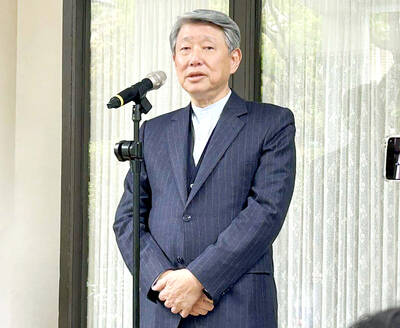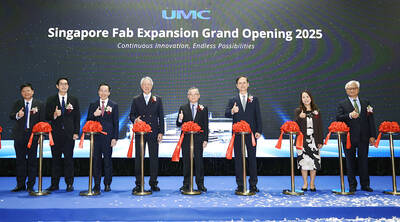Purushottan Sakhare perches on a wall by a Mumbai pavement, slips a sheet of green paper behind the roller of his battered typewriter and winds it into position with two deft flicks of the wrist.
After pulling the carriage release lever towards himself, he punches the worn, black keys, the swift and precise movements of his fingers sending the slender metal typebars slamming into the black ink ribbon.
Soon, the form he’s typing is ready to be authenticated with a wax seal and rubber stamp by one of the dozens of notaries waiting for passing trade under the colonnade entrance of the Mumbai Metropolitan Magistrates Court over the road.

Photo: AFP
“A typewriter is perfect for this kind of work,” said the 46-year-old, looking up from the aging Underwood model on a makeshift desk in front of him. “It’s fast and immediate.”
More than a dozen unofficial petition writers like Sakhare can be found hunched over portable typewriters on the same busy pavement, the sound of their work drowned out by the noisy traffic of India’s financial hub.
Inside the court precincts, a similar number of workers can be found under a flimsy, corrugated iron lean-to, typing affidavits, family title deeds and court applications for 10 rupees (US$0.22) per page.
Typewriters have largely been consigned to history in many countries and might be expected to have also been sent for scrap in Mumbai, where India does business with the world and the latest technology drives the country’s economic boom.
However, the unmistakeable clatter of typewriter keys and ping of margin bells can still be heard, echoing down the vaulted corridors of the courts and lawyers’ chambers to police stations and government offices across the city.
Santosh Pratap Sangtani, from the Bombay Typewriter Company, is thankful that the sturdy machines that were a feature of business from the late 19th century through most of the following 100 years have not yet become museum pieces.
India once manufactured around 150,000 typewriters every year, but five years ago he was unsure whether there would still be a demand for his services, as typewriter factories closed and the take-up of information technology increased.
“A lot of the resurgence has to do with the government,” he said in his dusty first floor workshop above a busy side-street near the city’s main railway station and post office.
“They have said that if you want a government job, you have to first learn how to type on a typewriter and produce a course certificate. Only then can you move on to a computer. Typing institutes that closed have now reopened,” Sangtani said.
With new typewriters unavailable, the Bombay Typewriter Company and others like it now make money by selling reconditioned machines for up to 6,000 rupees each.
Work on the hulks of Woodstock, Remington, Godrej and Facit models usually involves metal bashing and oiling or replacing the English, Hindi and Marathi keys, typebars, levers and rollers with specially made parts.
Like the court typist Sakhare, Sangtani believes the machines still have a place in modern India, despite a push to increase the use of computers and digitize the slow-moving state sector, where form-filling by hand is still largely the norm.
“Nowadays people who use computers use only a single finger. Ten minutes’ work takes half an hour. When you learn to touch-type on a typewriter, you use all your fingers and it’s quicker,” he said.
Users, many of them older and with an emotional attachment to their machines, also vouch for their preference for typewriters over new-fangled computers because of their low maintenance costs and simplicity.
“If you’re doing work on a computer and I’m doing work on a typewriter, I will get it done first,” one court writer boasted.
The machines are also an ideal tool in a country where about 400 million people lack regular electricity and where power cuts can be daily occurrences even where electricity it is available.
Nevertheless, Mumbai’s professional typists and repairers are realistic. The cost of computers is falling and more Indians are getting online, including through their mobile phones.
“I think the situation will last for another four to five years,” Sangtani said. “After that, who knows?”

MULTIFACETED: A task force has analyzed possible scenarios and created responses to assist domestic industries in dealing with US tariffs, the economics minister said The Executive Yuan is tomorrow to announce countermeasures to US President Donald Trump’s planned reciprocal tariffs, although the details of the plan would not be made public until Monday next week, Minister of Economic Affairs J.W. Kuo (郭智輝) said yesterday. The Cabinet established an economic and trade task force in November last year to deal with US trade and tariff related issues, Kuo told reporters outside the legislature in Taipei. The task force has been analyzing and evaluating all kinds of scenarios to identify suitable responses and determine how best to assist domestic industries in managing the effects of Trump’s tariffs, he

TIGHT-LIPPED: UMC said it had no merger plans at the moment, after Nikkei Asia reported that the firm and GlobalFoundries were considering restarting merger talks United Microelectronics Corp (UMC, 聯電), the world’s No. 4 contract chipmaker, yesterday launched a new US$5 billion 12-inch chip factory in Singapore as part of its latest effort to diversify its manufacturing footprint amid growing geopolitical risks. The new factory, adjacent to UMC’s existing Singapore fab in the Pasir Res Wafer Fab Park, is scheduled to enter volume production next year, utilizing mature 22-nanometer and 28-nanometer process technologies, UMC said in a statement. The company plans to invest US$5 billion during the first phase of the new fab, which would have an installed capacity of 30,000 12-inch wafers per month, it said. The

‘SWASTICAR’: Tesla CEO Elon Musk’s close association with Donald Trump has prompted opponents to brand him a ‘Nazi’ and resulted in a dramatic drop in sales Demonstrators descended on Tesla Inc dealerships across the US, and in Europe and Canada on Saturday to protest company chief Elon Musk, who has amassed extraordinary power as a top adviser to US President Donald Trump. Waving signs with messages such as “Musk is stealing our money” and “Reclaim our country,” the protests largely took place peacefully following fiery episodes of vandalism on Tesla vehicles, dealerships and other facilities in recent weeks that US officials have denounced as terrorism. Hundreds rallied on Saturday outside the Tesla dealership in Manhattan. Some blasted Musk, the world’s richest man, while others demanded the shuttering of his

Taiwan’s official purchasing managers’ index (PMI) last month rose 0.2 percentage points to 54.2, in a second consecutive month of expansion, thanks to front-loading demand intended to avoid potential US tariff hikes, the Chung-Hua Institution for Economic Research (CIER, 中華經濟研究院) said yesterday. While short-term demand appeared robust, uncertainties rose due to US President Donald Trump’s unpredictable trade policy, CIER president Lien Hsien-ming (連賢明) told a news conference in Taipei. Taiwan’s economy this year would be characterized by high-level fluctuations and the volatility would be wilder than most expect, Lien said Demand for electronics, particularly semiconductors, continues to benefit from US technology giants’ effort